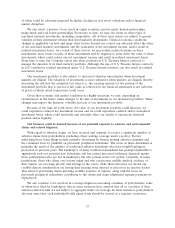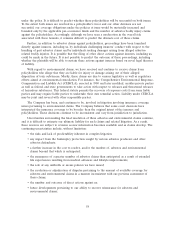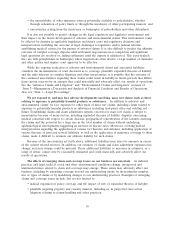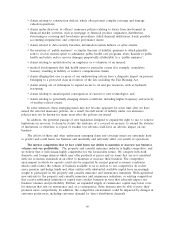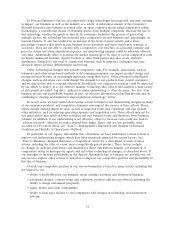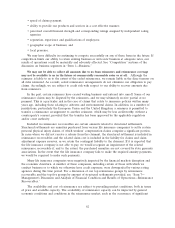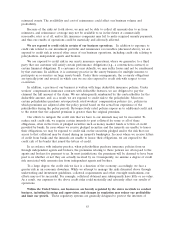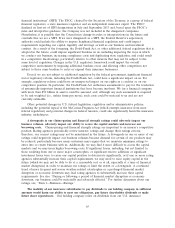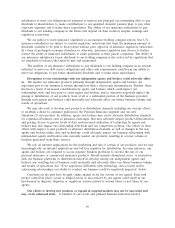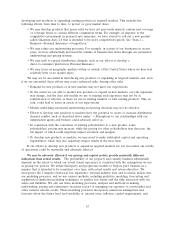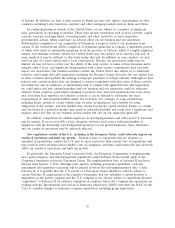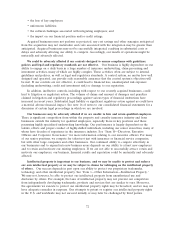Travelers 2013 Annual Report Download - page 73
Download and view the complete annual report
Please find page 73 of the 2013 Travelers annual report below. You can navigate through the pages in the report by either clicking on the pages listed below, or by using the keyword search tool below to find specific information within the annual report.reinsured events. The availability and cost of reinsurance could affect our business volume and
profitability.
Because of the risks set forth above, we may not be able to collect all amounts due to us from
reinsurers, and reinsurance coverage may not be available to us in the future at commercially
reasonable rates or at all, and/or life insurance companies may fail to make required annuity payments,
and thus our results of operations could be materially and adversely affected.
We are exposed to credit risk in certain of our business operations. In addition to exposure to
credit risk related to our investment portfolio and reinsurance recoverables (discussed above), we are
exposed to credit risk in several other areas of our business operations, including credit risk relating to
policyholders, independent agents and brokers.
We are exposed to credit risk in our surety insurance operations, where we guarantee to a third
party that our customer will satisfy certain performance obligations (e.g., a construction contract) or
certain financial obligations. If a customer of ours defaults, we may suffer losses and not be reimbursed
by that customer. In addition, it is customary practice in the surety business for multiple insurers to
participate as co-sureties on large surety bonds. Under these arrangements, the co-surety obligations
are typically joint and several, in which case we are also exposed to credit risk with respect to our
co-sureties.
In addition, a portion of our business is written with large deductible insurance policies. Under
workers’ compensation insurance contracts with deductible features, we are obligated to pay the
claimant the full amount of the claim. We are subsequently reimbursed by the contractholder for the
deductible amount, and, as a result, we are exposed to credit risk to the policyholder. Moreover,
certain policyholders purchase retrospectively rated workers’ compensation policies (i.e., policies in
which premiums are adjusted after the policy period based on the actual loss experience of the
policyholder during the policy period). Retrospectively rated policies expose us to additional credit risk
to the extent that the adjusted premium is greater than the original premium.
Our efforts to mitigate the credit risk that we have to our insureds may not be successful. To
reduce such credit risk, we require certain insureds to post collateral for some or all of these
obligations, often in the form of pledged securities such as money market funds or letters of credit
provided by banks. In cases where we receive pledged securities and the insureds are unable to honor
their obligations, we may be exposed to credit risk on the securities pledged and/or the risk that our
access to that collateral may be stayed during an insured’s bankruptcy. In cases where we receive letters
of credit from banks and the insureds are unable to honor their obligations, we are exposed to the
credit risk of the banks that issued the letters of credit.
In accordance with industry practice, when policyholders purchase insurance policies from us
through independent agents and brokers, the premiums relating to those policies are often paid to the
agents and brokers for payment to us. In most jurisdictions, the premiums will be deemed to have been
paid to us whether or not they are actually received by us. Consequently, we assume a degree of credit
risk associated with amounts due from independent agents and brokers.
To a large degree, the credit risk we face is a function of the economy; accordingly, we face a
greater risk in an economic downturn. While we attempt to manage the risks discussed above through
underwriting and investment guidelines, collateral requirements and other oversight mechanisms, our
efforts may not be successful. For example, collateral obtained may subsequently have little or no value.
As a result, our exposure to the above credit risks could materially and adversely affect our results of
operations.
Within the United States, our businesses are heavily regulated by the states in which we conduct
business, including licensing and supervision, and changes in regulation may reduce our profitability
and limit our growth. These regulatory systems are generally designed to protect the interests of
63






